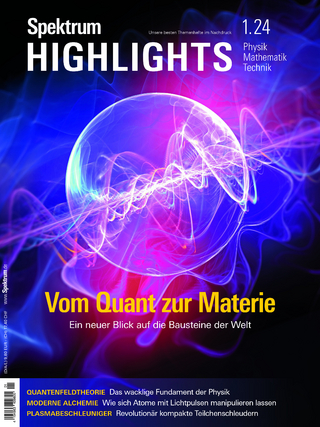
Spinors in Physics
Springer-Verlag New York Inc.
978-1-4612-7163-5 (ISBN)
- Titel ist leider vergriffen;
keine Neuauflage - Artikel merken
I Spinors in Three-Dimensional Space.- 1 Two-Component Spinor Geometry.- 1.1 Definition of a Spinor.- 1.1.1 Stereographic Projection.- 1.1.2 Vectors Associated with a Spinor.- 1.1.3 The Definition of a Spinor.- 1.2 Geometrical Properties.- 1.2.1 Plane Symmetries.- 1.2.2 Rotations.- 1.2.3 The Olinde—Rodrigues Parameters.- 1.2.4 Rotations Defined in Terms of the Euler Angles.- 1.3 Infinitesimal Properties of Rotations.- 1.3.1 The Infinitesimal Rotation Matrix.- 1.3.2 The Pauli Matrices.- 1.3.3 Properties of the Pauli Matrices.- 1.4 Algebraic Properties of Spinors.- 1.4.1 Operations on Spinors.- 1.4.2 Properties of Operations on Spinors.- 1.4.3 The Basis of the Vector Space of Spinors.- 1.4.4 Hermitian Vector Spaces.- 1.4.5 Properties of the Hermitian Product.- 1.4.6 The Use of an Antisymmetric Metric Tensor.- 1.5 Solved Problems.- 2 Spinors and SU (2) Group Representations.- 2.1 Lie Groups.- 2.1.1 Examples of Continuous Groups.- 2.1.2 Analytic Definition of Continuous Groups.- 2.1.3 Linear Representations.- 2.1.4 Infinitesimal Generators.- 2.1.5 Infinitesimal Matrices.- 2.1.6 Exponential Mapping.- 2.1.7 The Nomenclature of Continuous Linear Groups.- 2.2 Unimodular Unitary Groups.- 2.2.1 The Unitary Group U (2).- 2.2.2 The Unitary Unimodular Group SU (2).- 2.2.3 Three-Dimensional Representations.- 2.2.4 Representations of the Groups SU (2).- 2.2.5 Irreducible Representations of SU (2).- 2.3 Solved Problems.- 3 Spinor Representation of SO (3).- 3.1 The Rotation Group SO (3).- 3.1.1 Rotations About a Point.- 3.1.2 The Infinitesimal Matrices of the Group.- 3.1.3 Rotations About a Given Axis.- 3.1.4 The Exponential Matrix of a Rotation About a Given Axis.- 3.2 Irreducible Representations of SO (3).- 3.2.1 The Structure Equations.- 3.2.2 The Infinitesimal Matrices of the Representations of the Group SO (3).- 3.2.3 Eigenvectors and Eigenvalues of the Infinitesimal Matrices of the Representations.- 3.2.4 Irreducible Representations.- 3.2.5 The Infinitesimal Matrices of an Irreducible Representation in the Canonical Basis.- 3.2.6 The Characters of the Rotation Matrices of a Representation.- 3.3 Spherical Harmonics.- 3.3.1 The Infinitesimal Operators in Spherical Coordinates.- 3.3.2 Spherical Harmonics.- 3.4 Spinor Representations.- 3.4.1 The Two-Dimensional Irreducible Representation.- 3.4.2 The Three-Dimensional Irreducible Representation.- 3.4.3 (2 j + 1)-Dimensional Irreducible Representations.- 3.5 Solved Problems.- 4 Pauli Spinors.- 4.1 Spin and Spinors.- 4.2 The Linearized Schrödinger Equations.- 4.2.1 The Free Particle.- 4.2.2 Particle in an Electromagnetic Field.- 4.2.3 The Spinors in Pauli’s Equation.- 4.3 Spinor and Vector Fields.- 4.3.1 The Transformation of a Vector Field by a Rotation.- 4.3.2 The Rotation of a Spinor Field.- 4.4 Solved Problems.- II Spinors in Four-Dimensional Space.- 5 The Lorentz Group.- 5.1 The Generalized Lorentz Group.- 5.1.1 Rotations and Reflections.- 5.1.2 Orthochronous and Anti-Orthochronous Transformations.- 5.1.3 Sheets of the Generalized Lorentz Group.- 5.2 The Four-Dimensional Rotation Group.- 5.2.1 Four-Dimensional Orthogonal Transformations.- 5.2.2 Matrix Representations of the Group SO (4).- 5.2.3 Infinitesimal Matrices.- 5.2.4 Irreducible Representations.- 5.3 Solved Problems.- 6 Representations of the Lorentz Groups.- 6.1 Irreducible Representations.- 6.1.1 Relations Between the Groups SO (3, 1)?andSO(4).- 6.1.2 Infinitesimal Matrices.- 6.1.3 Irreducible Representations.- 6.2 The Group SL(2,?).- 6.2.1 Two-Component Spinors.- 6.2.2 Higher-Order Spinors.- 6.2.3 Representations of the GroupsSL(2,?).- 6.2.4 Irreducible Representations.- 6.3 Spinor Representations of the Lorentz Group.- 6.3.1 Four-Dimensional Irreducible Representations.- 6.3.2 Two-Dimensional Representations.- 6.3.3 The Direct Product of Irreducible Representations.- 6.4 Solved Problems.- 7 Dirac Spinors.- 7.1 The Dirac Equation.- 7.1.1 The Classical Relativistic Wave Equation.- 7.1.2 The Dirac Equation for a Free Particle.- 7.1.3 A Particle in an Electromagnetic Field.- 7.2 Relativistic Invariance of the Dirac Equation.- 7.2.1 The Relativistic Invariance Condition.- 7.2.2 The Type of Representation for the Wave Function.- 7.2.3 The Link Between a Spinor and a Four-Vector.- 7.2.4 Dirac’s Equation in the Spinor Representation.- 7.2.5 The Symmetric Form of the Dirac Equation.- 7.3 Solved Problems.- 8 Clifford and Lie Algebras.- 8.1 Lie Algebras.- 8.1.1 The Definition of an Algebra.- 8.1.2 Lie Algebras.- 8.1.3 Isomorphic Lie Algebras.- 8.2 Representations of Lie Algebras.- 8.2.1 Definition.- 8.2.2 Representations of a Lie Group and of Its Lie Algebra.- 8.2.3 Connected Groups.- 8.2.4 Reducible and Irreducible Representations.- 8.3 Clifford Algebras.- 8.3.1 Definition.- 8.3.2 Examples of Clifford Algebras.- 8.3.3 Clifford and Lie Algebras.- 8.3.4 Spinor Groups.- 8.4 Solved Problems.- Appendix: Groups and Their Representations.- A.1 The Definition of a Group.- A.1.1 Examples of Groups.- A.1.2 The Axioms Defining a Group.- A.1.3 Elementary Properties of Groups.- A.2 Linear Operators.- A.2.1 The Operator Representing an Element of a Group.- A.2.2 The Operators Acting on the Vectors of Geometric Space.- A.2.3 The Operators Acting on Wave Functions.- A.2.4 Operators Representing a Group.- A.3 Matrix Representations.- A.3.1 The Rotation Matrix Acting on the Vectors of a Three-Dimensional Space.- A.3.2 The Matrix of an Operator Acting on Functions.- A.3.3 The Matrices Representing the Elements of a Group.- A.4 Matrix Representations.- A.4.1 The Definition of a Matrix Representation.- A.4.2 The Fundamental Property of the Matrices of a Representation.- A.4.3 Representation by Regular Matrices.- A.4.4 Equivalent Representations.- A.5 Reducible and Irreducible Representations.- A.5.1 The Direct Sum of Two Vector Spaces.- A.5.2 The Direct Sum of Two Representations.- A.5.3 Irreducible Representations.- A.6 The Direct Product of Representations.- A.6.1 The Direct Product of Two Matrices.- A.6.2 Properties of Tensor Products of Matrices.- A.6.3 The Direct Product of Two Representations.- References.
| Reihe/Serie | Graduate Texts in Contemporary Physics |
|---|---|
| Übersetzer | J. M. Cole |
| Zusatzinfo | XI, 226 p. |
| Verlagsort | New York, NY |
| Sprache | englisch |
| Maße | 155 x 235 mm |
| Gewicht | 379 g |
| Themenwelt | Mathematik / Informatik ► Mathematik |
| Naturwissenschaften ► Physik / Astronomie ► Hochenergiephysik / Teilchenphysik | |
| Naturwissenschaften ► Physik / Astronomie ► Quantenphysik | |
| Naturwissenschaften ► Physik / Astronomie ► Theoretische Physik | |
| ISBN-10 | 1-4612-7163-0 / 1461271630 |
| ISBN-13 | 978-1-4612-7163-5 / 9781461271635 |
| Zustand | Neuware |
| Haben Sie eine Frage zum Produkt? |
aus dem Bereich


